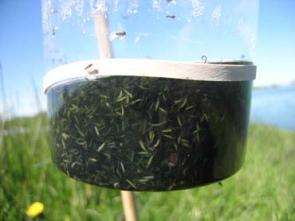UW–Madison scientists are using large plastic buckets to trap gnat-like bugs known as “midges” that periodically rise up by the trillions to form thick, hovering swarms. Photo: Jack Donaldson
Wisconsin ecologists have ventured into remote parts of Iceland to explore a startling phenomenon in which trillions of gnat-like bugs periodically rise up to form hovering swarms so thick they resemble waves of morning fog.
The insects — or “midges” — feed in lake sediments as young larvae before rising up to mate and swarm as adults. But more than half the midges eventually float back down and die on land, rather than the lake water from which they rose up.
In moving from lake to land, the midges may be providing a powerful and unique ecological service in which energy and nutrients — in the form of the midges themselves — flow directly from an aquatic ecosystem to a terrestrial one.
“The midges are like tiny packets of nitrogen,” says project leader Claudio Gratton, an assistant professor of entomology. “We want to determine the ecological consequences of that movement of energy to answer the question: Is the lake fueling productivity on land?”
Gratton and his team are in the early stages of addressing that question; the researchers just returned from their first expedition to Iceland. They plan to study and compare midge swarms in several Icelandic lakes during the next few years, but the primary research site is Lake Myvatn, a beautiful body of water in northern Iceland that sees tremendous swarms twice a year.
More broadly, the Iceland work could help elicit a whole new approach to studying ecosystems — and one that might be just as relevant in Wisconsin. “People have tended to focus on ecosystems as closed, singular systems,” says Gratton. “But we now need to address the idea that they are actually interconnected.”
Here in Wisconsin, that idea could translate to studies on agricultural pests, for example, in that scientists could start to look beyond the field to assess how other ecosystems impact a pest’s success.
“A farmer’s field is not just an isolated unit,” Gratton says. “So in order to understand how to control a pest, maybe we have to understand what it and its natural enemies are doing outside of a field of crops.”
Source: by Paroma Basu, UW–Madison
























